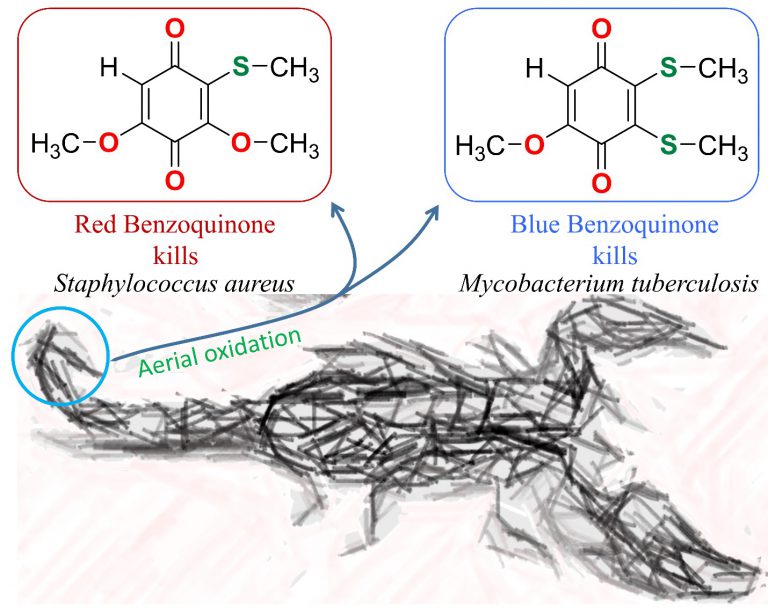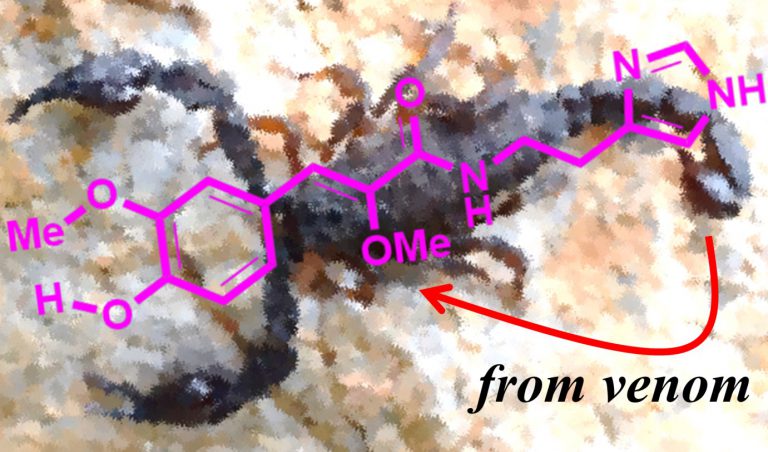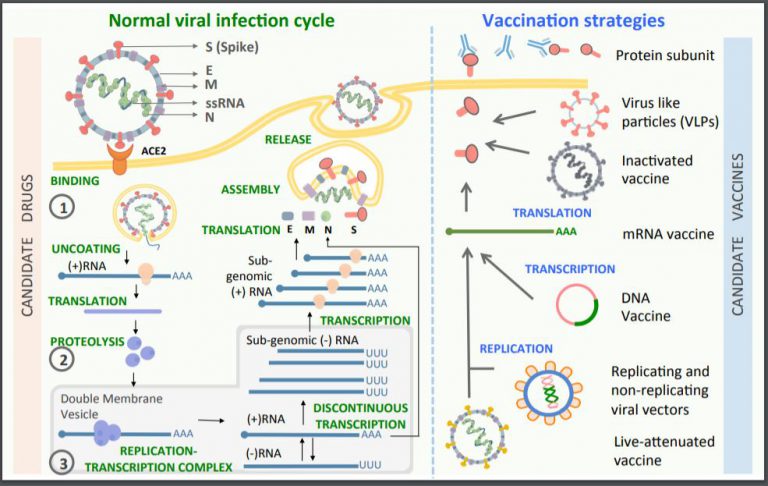Research Highlights
Homologous recombination (HR) is one of the key pathways to repair double-strand breaks (DSBs). In higher organisms, rad51 function is indispensable with its absence leading to early embryonic lethality, thus precluding any mechanistic probing of the system. We used Drosophila as the model system to study the requirement of rad51 in somatic tissue. Our study for the first time revealed the tissue specific defects in rad51 mutants caused by defective DNA repair in the developing tissue. We also uncover unique low temperature sensitivity of rad51 mutants, implicating a role of rad51 in regulating temperature sensitive cellular processes. Our study put forward a viable model to study rad51 function; such studies were previously restricted due to early lethality of mouse model.

Figure legend: Schematic showing Rad51 protein in strand-exchange step of homologous recombination (A). Bright field photograph of control and Drosophila rad51 mutant depicting defective patterning of abdominal cuticle (B). III instar larval wing imaginal disc stained for cell death (red) and actin (green) in control (C) and mutant (D).
 Image credit: A & A 2020 Betelgeuse is a distinctly reddish semiregular variable star, 700 light years away, in the constellation of Orion, (Thiruvathira Nakshatram)
Its sudden dimming in late 2019 has mystified astronomers, who got busy with several theories for this abrupt change. One idea proposed was that a huge, cool, dark “star spot” covered a wide patch of the visible surface, while another suggestion was suggest a dust cloud must be covering a portion of the star. Another report says the dimming was caused by a huge cloud of material that the supergiant star blasted into space.
In the fall of 2019, Betelgeuse began dimming significantly, losing about two-thirds of its brightness by February. Hydrodynamic models had suggested that Betelgeuse was close to going supernova in the next 10,000 years or so. So the first speculation was that the dimming was a sign of the same. However from the end of February onwards, the star started rapidly brightening again, putting astronomers into dilemma again.
Recently Prof G Ambika and her collaborators looked into 30 years of Visual data reported by amateur astronomers prior to the dimming episode of 2019-20, using an approach from dynamical systems theory. They found early warning signals of a critical transition in its dynamics, as indicated by increase in values of a set of measures that started much earlier, in the 30 year period leading to the present transition.
Their results indicate a change in the underlying pulsation dynamics that may be responsible for the dimming and brightening episode of 2019-20. Recent observations by STEREO and amateur astronomers from AAVSO suggest another dimming episode is underway, giving credence to this finding of changes in dynamics.
The study is published in Astronomy and Astrophysics (Click Here)
Image credit: A & A 2020 Betelgeuse is a distinctly reddish semiregular variable star, 700 light years away, in the constellation of Orion, (Thiruvathira Nakshatram)
Its sudden dimming in late 2019 has mystified astronomers, who got busy with several theories for this abrupt change. One idea proposed was that a huge, cool, dark “star spot” covered a wide patch of the visible surface, while another suggestion was suggest a dust cloud must be covering a portion of the star. Another report says the dimming was caused by a huge cloud of material that the supergiant star blasted into space.
In the fall of 2019, Betelgeuse began dimming significantly, losing about two-thirds of its brightness by February. Hydrodynamic models had suggested that Betelgeuse was close to going supernova in the next 10,000 years or so. So the first speculation was that the dimming was a sign of the same. However from the end of February onwards, the star started rapidly brightening again, putting astronomers into dilemma again.
Recently Prof G Ambika and her collaborators looked into 30 years of Visual data reported by amateur astronomers prior to the dimming episode of 2019-20, using an approach from dynamical systems theory. They found early warning signals of a critical transition in its dynamics, as indicated by increase in values of a set of measures that started much earlier, in the 30 year period leading to the present transition.
Their results indicate a change in the underlying pulsation dynamics that may be responsible for the dimming and brightening episode of 2019-20. Recent observations by STEREO and amateur astronomers from AAVSO suggest another dimming episode is underway, giving credence to this finding of changes in dynamics.
The study is published in Astronomy and Astrophysics (Click Here) Image credit: Sreenivas Chavali, Anjali K Singh, M. Madan Babu
Original article: Click Here
Image credit: Sreenivas Chavali, Anjali K Singh, M. Madan Babu
Original article: Click HereThe venom of poisonous animals is a complicated cocktail of proteins, peptides, and many other chemicals, not all of which are harmful. A recent study conducted by Shibdas Banerjee (IISER Tirupati) in collaboration with Richard N. Zare (Stanford University), Lourival D. Possani (UNAM Mexico), and Rogelio Hernández-Pando (INCMNSZ Mexico) finds two new color-changing benzoquinone compounds from the venom of a scorpion (Diplocentrus melici). The existence and biological role of such nonproteinic natural products in the scorpion venom is still a mystery. The team has also developed the laboratory method of synthesizing those compounds; one is red and the other is blue in color when exposed to air. While the red compound shows antimicrobial activity against Staphylococcus aureus, the blue one effectively kills Mycobacterium tuberculosis and even a multidrug-resistant (MDR) strain with nearly equal effectiveness. These antimicrobial activities are comparable to the commercially available antibiotics used against these pathogens. Study with in vivo mouse models showed a significant decrease in pulmonary bacillary loads and tissue damage when the mice with late-stage MDR-TB infection were administered the blue benzoquinone. The healthy mice (negative controls) tolerated the treatment well without adverse side effects. The study has been recently published in the journal Proceedings of the National Academy of Sciences USA highlighting potential pharmacological treasures hidden in the venom of dangerous animals.
Original article:
www.pnas.org/content/early/2019/06/06/1812334116

Image credit: S. Banerjee
 Recurrence networks constructed from the light curves of four pulsating variable stars belonging to the RRc Lyrae category, displayed against background of variable star AG Carinae from Hubble Legacy Archive. (Background image credits: Judy Schmidt [CC0], from Wikimedia Commons).
Recurrence networks constructed from the light curves of four pulsating variable stars belonging to the RRc Lyrae category, displayed against background of variable star AG Carinae from Hubble Legacy Archive. (Background image credits: Judy Schmidt [CC0], from Wikimedia Commons).
 Multifractal parameters of ECG from normal heart (green) differentiated from that of abnormal heart data.
Multifractal parameters of ECG from normal heart (green) differentiated from that of abnormal heart data.The whole scenario is different when a drop wets and spreads on a surface that contains dispersed powder. The spreading of a drop occurs in a blink of an eye. When the drop spreads, its edge pushes on the powder particles and forms rings. Here, physics of drop spreading and imbibition into the powder layer plays a role. We study these effects and look at the resulting patterns formed.
The scenario is further different when the drop impacts on a powder layer with some kinetic energy. Here, the drop, as it impinges on the surface, can entrap a layer of air. This forms a bubble inside the drop. The dynamics of this bubble displaces the powder layer in particular manner.
Physics behind such everyday phenomena are studied in Microfluidics Group of Dr. Dileep Mampallil.

Rings formed on a soot layer upon spreading of an ethanol drop. See Phys. Rev. E. 98, 043107, (2018).
Scorpion is known for its painful sting. Relatively less known fact is that the scorpion venom, world’s most expensive liquid (~10 million USD/Litre), is enriched with many important natural products, which can fight cancer and autoimmune disorders. Recent study by Shibdas Banerjee et al. has reported a new alkaloid from the scorpion venom, while most venom components identified in past are peptidic or proteinic in nature. This news has surprised the world and recently mentioned in Chemical and Engineering News (C&EN). The study was conducted in collaboration with the laboratories of Prof. Richard N. Zare, Stanford University, and Prof. Lourival D. Possani, UNAM, Mexico. Scorpions use their venom to paralyze their prey. However, this alkaloid was not found to have insecticidal activity. The exact role of this alkaloid in the venom is still a mystery. A chemical method of synthesizing the alkaloid has also been developed. Authors suggest that this venom alkaloid might be of potential interest for evaluating its medicinal effect.
Original article: Banerjee et al. Journal of Natural Products, 2018, DOI:10.1021/acs.jnatprod.8b00527
C&EN highlight: https://cen.acs.org/biological-chemistry/natural-products/Scorpion-venom-yields-novel-alkaloid/96/web/2018/08
CANCER
A mechanistic understanding of cancer growth is critical to identify new therapeutic approaches to combat human cancers. Our research work in cancer biology centres around understanding the roles of NF-kB and MAPK signalling in the regulation of oncogenes, tumor-immune system cross-talk and the link between inflammation and cancer. One of the major questions addressed is how cross-talk between different signal transduction pathways fine-tunes the gene expression signatures of cancerous and healthy immune cells. V Siva Kumar’s research group focuses primarily on identifying molecules or molecular complexes to which cancer cells are addicted for survival, regardless of the causative oncogenic mutations. At IISER Tirupati, the cancer group also focuses on understanding the molecular mechanisms of signal transduction, gene regulation and the functionality of oncogenes/ co-regulators in the development of human cancers and metastasis. Recent work has identified the vital roles of Metastasis Associated Protein 1 (MTA1) in epithelial – mesenchymal transitions, metastasis and several other new physiological functions in DNA damage, inflammatory responses and infection. Pakala Suresh Babu’s research group focuses on understanding the emerging roles of MTA1, which in turn would lead to development of MTA1 – targeted therapy for combating not only cancer but also for inflammation and pathogen-driven pathologic conditions.
At IISER Tirupati, the cancer group also focuses on understanding the molecular mechanisms of signal transduction, gene regulation and the functionality of oncogenes/ co-regulators in the development of human cancers and metastasis. Recent work has identified the vital roles of Metastasis Associated Protein 1 (MTA1) in epithelial – mesenchymal transitions, metastasis and several other new physiological functions in DNA damage, inflammatory responses and infection. Pakala Suresh Babu’s research group focuses on understanding the emerging roles of MTA1, which in turn would lead to development of MTA1 – targeted therapy for combating not only cancer but also for inflammation and pathogen-driven pathologic conditions.
 An aptamer based tumor targeted drug delivery approach is underway in the research group of Ashwani Sharma (Ash Lab). Aptamer is a single stranded DNA or RNA (15 to 70 base length), which has high affinity and specificity for its target and is an oligonucleotide-based substitute to protein antibodies and has been shown to overcome the weaknesses of antibodies. Utilizing state-of-the-art RNA nanotechnology platforms decorated with aptamers and oligotherapeutics such as siRNA, Ash lab focuses on the target specific delivery to different cancers such as breast, colon and lung cancers. The lab also focuses on designing detection and diagnostic platforms for early detection of cancer utilizing target specific recognition of DNA/RNA aptamers.
In addition to new therapeutic approaches, the institute is also involved in developing methods for early diagnosis of cancer using modern techniques. Shibdas Banerjee’s group focuses especially on clinical mass spectrometry imaging, coupled with discovery of new disease biomarkers.
An aptamer based tumor targeted drug delivery approach is underway in the research group of Ashwani Sharma (Ash Lab). Aptamer is a single stranded DNA or RNA (15 to 70 base length), which has high affinity and specificity for its target and is an oligonucleotide-based substitute to protein antibodies and has been shown to overcome the weaknesses of antibodies. Utilizing state-of-the-art RNA nanotechnology platforms decorated with aptamers and oligotherapeutics such as siRNA, Ash lab focuses on the target specific delivery to different cancers such as breast, colon and lung cancers. The lab also focuses on designing detection and diagnostic platforms for early detection of cancer utilizing target specific recognition of DNA/RNA aptamers.
In addition to new therapeutic approaches, the institute is also involved in developing methods for early diagnosis of cancer using modern techniques. Shibdas Banerjee’s group focuses especially on clinical mass spectrometry imaging, coupled with discovery of new disease biomarkers.
TUBERCULOSIS
Our research on tuberculosis revolves around understanding the biology of Mycobacterium tuberculosis with the objective to develop strategies for shortening treatment time and also to enable early diagnosis of this sub-clinical disease. We concentrate on two interconnected areas-improving drug permeation and enhancing drug efficacy. We focus on identifying key outer membrane channel forming proteins that are essential for nutrient and antibiotic uptake in order to understand factors which allow permeation of new chemical entities (NCEs) across the otherwise impermeable mycobacterial outer membrane. Raju Mukherjee’s research group employs both proteomic and chemical genomic tools to identify such channel proteins and other factors (intrinsic resistome) that mitigate the efficacy of current drugs leading to anti-microbial resistance. In addition, we are aiming to develop a diagnostic tool to detect the sub-clinical asymptomatic manifestation of the disease by exploiting the strong cell-cell interaction mediated by glycolipids and cell surface carbohydrates.
MALARIA
According to the WHO-UNICEF Report 2015, India stands third in the number of deaths due to malaria. This increased mortality is associated with 67% rise in falciparum cases in the last decade. Further, recent clinical reports from Orissa and Karnataka show high severity among blood group B patients. The severity of malaria is caused by formation of clumps of parasitized RBC with uninfected RBCs in the microvasculature leading to blockage of blood flow resulting into organ failure and deaths. Since one-third of the Indian population has blood group B, it is imperative to identify the parasite molecule that binds to blood group B to cause increased agglutination. This will have direct implication towards development of therapeutics against severe malaria, specifically in the Indian perspective. Besides agglutination, blockage of blood flow is also mediated by binding of parasites to various host endothelial cell surface proteins such as ICAM-1, CD31, EPCR, CD36 and gC1qR expressed on endothelial cell surface. However, these proteins are expressed at low levels and need to highly up-regulate to achieve the levels of sequestration observed during severity. Recently it was shown that Extracellular Vesicles (EVs) from Mycobacterium could up-regulate the expression of ICAM-1. Suchi Goel’s research group aims to understand if parasite-derived EVs affect global expression profile of host receptors and hence sequestration. EVs are also being examined as a biomarker for early detection of severe malaria, as they are present in high density.

DISCOVERING INDIA’s HIDDEN GENETIC AND CULTURAL BIODIVERSITY
Although India hosts several global biodiversity hotspots, our recent research using modern genetic tools reveals that there are several species that have not yet been described from the Indian forests. Our research has described new bird species and genera, uncovering evolutionary patterns that reveal the role of mountain systems along with ancient climate in driving speciation. We also find that bird song, an indicator of cultural diversity, has undergone diversification not only across different mountains, but also across isolation created by deforestation. We collaborate with engineers to develop an automated system to identify and detect dialects of different bird songs. A parallel effort includes documenting the extent of landscape change using remote-sensing data. We continue to explore landscapes across India to describe evolutionary and biogeographic patterns using advanced genetic and genomic data.PREDICTING IMPACTS OF CLIMATE CHANGE
Multiple teams of researchers are working on documenting various impacts of climate change on the distribution and life history of birds and mammals across the Western Ghats and Himalayan landscapes, including Ladakh. Patterns of speciation and colonisation are unclear, and the use of genomic methods in addition to field observations can reveal broad scale patterns of colonisation as well as evolutionary patterns. We also work specifically on small mammals like squirrels, which though common, are often cryptic but respond to minor changes in habitat and the environment around them. Of particular interest are expansions of low-elevation species into higher elevations, and these species can modify their behaviours and adapt to changing conditions rapidly, sometimes within half a century. In these systems, we record impacts like demographic and genetic impacts of climate change, with a view to understanding microevolution within populations. Robin VV’s group largely works on bird systems in the Western Ghats, Andaman and Nicobar Islands and peninsular India. Nandini Rajamani’s group works on small mammals in the Trans-Himalayas of Ladakh and in the Western Ghats, understanding behaviour and adaptations of species to changing environments.
 Research at IISER Tirupati is focussed on developing the recovery process of possible materials like Ni, Co, Mn, Li, and carbon and re-using them for same charge storage applications. As Li-deposits are highly limited globally, developing alternate storage devices like Na, K, Mg and Al battery chemistries is essential. Vanchiappan Aravindan’s research group is exploring various new materials for energy storage technologies. In addition to batteries, super-capacitors are also considered a strong contender for electric vehicle applications, mostly based on high surface area carbons.
Research at IISER Tirupati is focussed on developing the recovery process of possible materials like Ni, Co, Mn, Li, and carbon and re-using them for same charge storage applications. As Li-deposits are highly limited globally, developing alternate storage devices like Na, K, Mg and Al battery chemistries is essential. Vanchiappan Aravindan’s research group is exploring various new materials for energy storage technologies. In addition to batteries, super-capacitors are also considered a strong contender for electric vehicle applications, mostly based on high surface area carbons.MATHEMATICS
Number theory and complex algebraic geometry, homotopy theory, differential geometry, harmonic analysis, algebraic and differential topology and theory of representations of p – adic groups.
CHEMISTRY
Bio-organic chemistry of peptides and nucleic acids, antisense therapeutics, nucleic acid based nanoparticles for drug delivery, total synthesis of natural products, bio-inorganic chemistry and activation of small molecules, computational and quantum chemistry and carbene stabilized zero valent heterodiatomic compounds.
PHYSICS
Modelling the structure and dynamics of galaxies and dark matter halos, experimental high energy physics, quantum chromodynamics, microfluidics, observational astrophysics (star formation), theoretical condensed matter physics (quantum magnetism), strongly correlated systems and atomically thin nanomaterials, non-linear dynamics, string theory, and atomic and molecular physics.
BIOLOGY
Cell adhesion in neuritogenesis and neurodegenaration.
EARTH AND CLIMATE SCIENCES
Minerology and ignesious petrology.


 Image credit: Raju Mukherjee, Dibya Saha
Image credit: Raju Mukherjee, Dibya Saha
